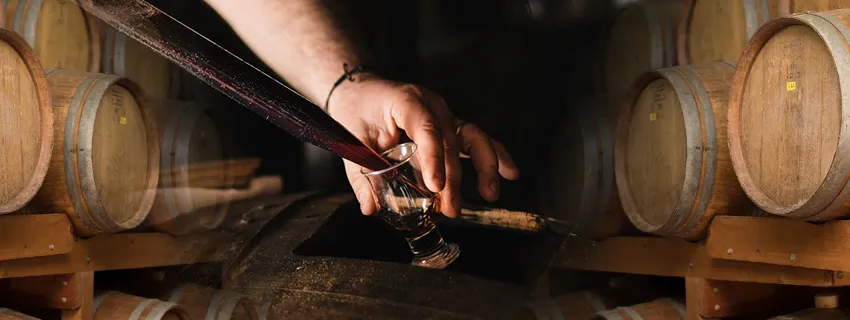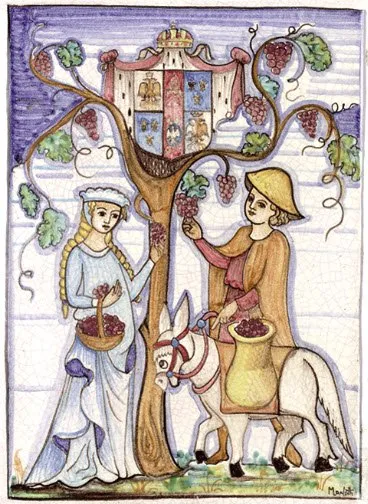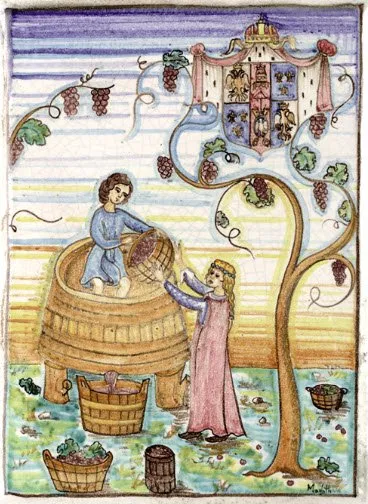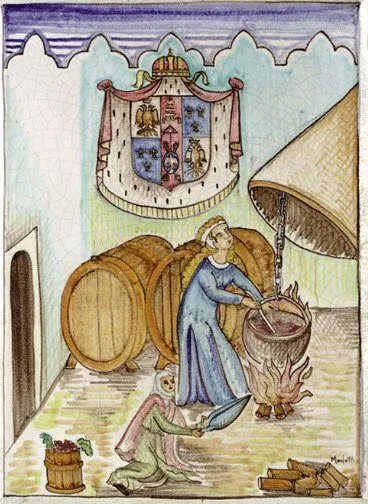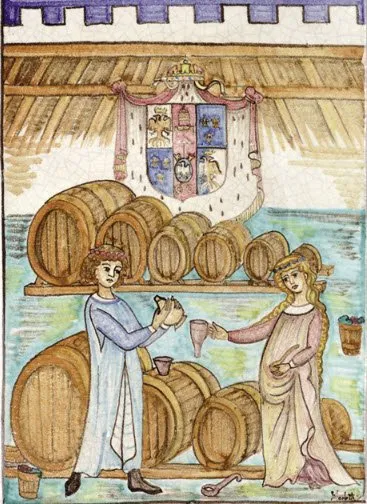Published:
Author: Antonio Maria Guerra
Balsamic Vinegar
HISTORY, INFO, PLACES, INTERESTING FACTS

Balsamic vinegar is one of the most appreciated Italian specialties. Part of its value is related to the fascinating events characterizing its past, when it was considered an elixir worthy of a king. Part derives from the quality of its grapes, the fruit of a specific territory, located between the ancient cities of Modena and Reggio Emilia. Let’s find out the secrets of this delicious product.

What is balsamic vinegar?
Balsamic Vinegar is a particular type of vinegar produced with grape must in two varieties:
Balsamic Vinegar of Modena PGI: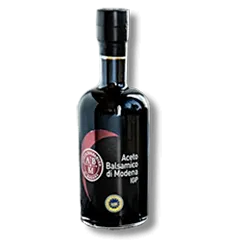 Made with grape must (cooked and / or concentrated), wine vinegar and, if required, a minimum percentage of caramel. Its aging in wooden barrels lasts from 60 days up to 3 years: if prolonged, the product gets the title of ‘Aged’ (‘Invecchiato’).
Made with grape must (cooked and / or concentrated), wine vinegar and, if required, a minimum percentage of caramel. Its aging in wooden barrels lasts from 60 days up to 3 years: if prolonged, the product gets the title of ‘Aged’ (‘Invecchiato’).
The specialty is protected by the European Union with the PGI (Protected Geographical Indication) trademark. Its grapes come from 7 typical vines, listed in the Production Regulations. The mixing of its ingredients, its maturation and aging processes, as well as its final certification must take place in the territories of the Provinces of Modena and Reggio Emilia, whereas bottling can be carried out elsewhere.
Read more
Traditional Balsamic Vinegar of Modena PDO and Reggio Emilia PDO: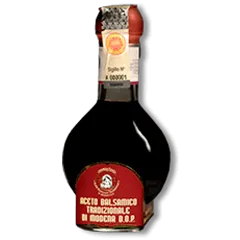 These specialties are prepared using only cooked must, made with grapes from the provinces, respectively, of Modena and Reggio Emilia. Both are characterized by a very long aging period, lasting from a minimum of 12 years, up to 25 for the extra-old type (‘extravecchio’).
These specialties are prepared using only cooked must, made with grapes from the provinces, respectively, of Modena and Reggio Emilia. Both are characterized by a very long aging period, lasting from a minimum of 12 years, up to 25 for the extra-old type (‘extravecchio’).
They are protected by the European Union with the PDO (Protected Designation of Origin) trademark. The entire production process, from the cultivation of grapes to bottling, must take place in the territory of the respective province.
In the past, the dark color and the great value of this delicacy have earned it the nickname of ‘black gold’ (‘oro nero’).
In this article we’ll show you the production method currently used for balsamic vinegar. To read it, please follow this LINK.
The lands of balsamic vinegar.
The provinces of Modena and Reggio Emilia are the birthplace of balsamic vinegar. They are both located in Emilia, the western part of the Italian region of Emilia-Romagna.

The origins of vinegar.
Vinegar is a product of very ancient origins: suffice to say that its use for the preservation of food favored the development of agriculture and the resulting, progressive sedentarization of nomadic hunting communities. Its contribution to the birth and development of the first civilizations was, therefore, huge: archaeological finds show that it was already in use by the Egyptians and the Babylonians.
Read more
Later on, it also spread among the Greeks and the Romans, who used it, among other things, as a condiment, medicine (*1), to sterilize water and in the preparation of drinks (*2).
It’s also important to remember that the process by which vinegar is formed was unknown to all these peoples: a mystery that lasted many centuries, until, in the Nineteenth Century, the French chemist Louis Pasteur formulated a complete scientific explanation (*3).
Notes:
*1: It was used, for example, to disinfect wounds;
*2: Like, for example, the Greek ‘Oxykraton’ and the Roman ‘Posca’;
*3: He understood the microbiological process transforming the sugars contained in grape juice into alcohol (the ‘fermentation’), and the subsequent formation of acetic acid following the oxidation of the alcohol itself;

The origins of the word ‘vinegar’.
The word ‘vinegar’ derives from the composition of two Latin words: ‘vinum’ (‘wine’) and ‘acre’ (‘acid’). The French ‘vinaigre’ derives from the same words.
In this regard, it’s interesting to note that the Italian term ‘aceto’ comes from ‘acetum’: name for the condiment already used at the time of ancient Rome.

Balsamic Vinegar
THE MOST TRADITIONAL PRODUCERS
This article is the result of the collaboration between WebFoodCulture, the Consorzio Tutela Aceto Balsamico di Modena IGP and the Consorzio Tutela Aceto Balsamico Tradizionale di Modena DOP.


The history of Balsamic Vinegar.
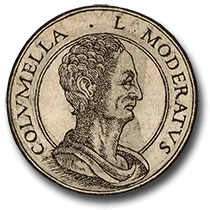 It’s possible that the Romans invented Balsamic Vinegar or, to be more precise, what by all means could be considered its ancestor, the ‘Sapa’ (or ‘Saba’) (*1): a dense and sweetish syrup with multiple uses (*2), prepared by cooking and reducing grape must (*3). Many are the ancient writers who refer to it in their works, including Virgil, Pliny the Elder and Ovid. Columella’s testimony is very interesting: in the ‘De re rustica’ he indicates the territories corresponding to the current provinces of Modena and Reggio Emilia as particularly suited to its production (*4).
It’s possible that the Romans invented Balsamic Vinegar or, to be more precise, what by all means could be considered its ancestor, the ‘Sapa’ (or ‘Saba’) (*1): a dense and sweetish syrup with multiple uses (*2), prepared by cooking and reducing grape must (*3). Many are the ancient writers who refer to it in their works, including Virgil, Pliny the Elder and Ovid. Columella’s testimony is very interesting: in the ‘De re rustica’ he indicates the territories corresponding to the current provinces of Modena and Reggio Emilia as particularly suited to its production (*4).
Read more
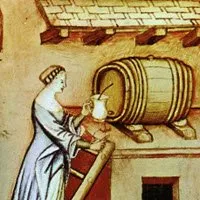 During the early Middle Ages, rumors spread about a ‘black gold’, characterized by qualities so legendary to become the object of the desire of a king: Henry II of Franconia (*5). This ‘black gold’, most likely, was nothing but the product currently known as Balsamic Vinegar, something considered so precious to be kept in small silver bottles.
During the early Middle Ages, rumors spread about a ‘black gold’, characterized by qualities so legendary to become the object of the desire of a king: Henry II of Franconia (*5). This ‘black gold’, most likely, was nothing but the product currently known as Balsamic Vinegar, something considered so precious to be kept in small silver bottles.
The fame of the specialty grew further over the centuries, so much to be mentioned, at the end of the Renaissance, in a work (*6) by Bartolomeo Scappi, the ‘cook of the Popes’.
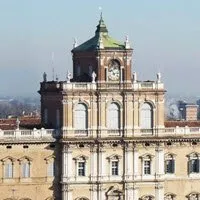 In the same period, the history of balsamic vinegar began to intertwine with that of the Dukes of Este, who had moved to the city of Modena. During the expansion of the Ducal Palace (Palazzo Ducale), Francesco I d’Este commissioned the fitting of an ‘acetaia’ (a vinegar cellar) in the spaces of the Torre del Prato.
In the same period, the history of balsamic vinegar began to intertwine with that of the Dukes of Este, who had moved to the city of Modena. During the expansion of the Ducal Palace (Palazzo Ducale), Francesco I d’Este commissioned the fitting of an ‘acetaia’ (a vinegar cellar) in the spaces of the Torre del Prato.
The first document associating the word ‘balsamico’ to the vinegar from Modena is the Register of Ducal cellars (1747): in addition to ‘common vinegar’ (‘aceto comune’), it refers to the ‘balsamic medium’ (‘mezzo balsamico’) and to the ‘fine balsamic’ (‘balsamico fine’). It’s believed that the use of this term could be related to the medicinal qualities (‘balsamic’) of the product and to its aroma.

The arrival of the Napoleonic troops in Modena in 1796 marked an epochal change for Balsamic Vinegar. Its economic value was immediately recognized by the French and the Ducal ‘acetaia’ was sold at auction: some wealthy bourgeois families took advantage of the situation by purchasing its ancient barrels. The commercial regulations issued by the newly formed Cisalpine Republic favored trades and Balsamic Vinegar, no longer prerogative of aristocratic families, was released to the market.
After the proclamation of the Kingdom of Italy, the producers of the ‘Balsamico’ began to participate to the recurring International Exhibitions: of particular importance was the International Exhibition of Paris in 1878, where it was definitely sanctioned the value of the specialty, recognizing its uniqueness in terms of taste and aroma.
The great success led to a differentiation in the production processes and the commercialization of a bittersweet and fragrant vinegar, more affordable and suitable for daily use. Two products emerged, known today as the Balsamic Vinegar of Modena PGI and the Traditional Balsamic Vinegar PDO (of Modena and Reggio Emilia), protected by the EU and promoted by their respective Consortia.
Notes:
*1: Also known as ‘defrutum’ or ‘caraenum’, depending on the density of the liquid;
*2: It was used, among other things, as a condiment (often mixed with the ‘Garum’, a sauce made with macerated fish) or as wine (thanks to the addition of water);
*3: Thanks to the reduction, must could no longer ferment and could withstand long journeys without altering;
*4: Columella points out that, sometimes, must fermented giving life to a specialty that, once aged, was very appetizing (the writer was unknowingly talking about the delicacy covered by this article);
*5: The chronicles of the time narrate that, in 1046, Boniface of Canossa (father of the famous Matilde), to get in good with King Henry, gave him a barrel of ‘defrutum’;
*6: ‘Opera. Dell’arte del cucinare’ (1570) by Bartolomeo Scappi, ‘secret cook’ of the Popes Pius IV and Pius IV;


Pavarotti’s music for the ‘Balsamico’.
The great tenor Luciano Pavarotti, born in the city of Modena, was notoriously a great lover of good food.
Read more
As you can easily imagine, he had a particular passion for the specialties from his native land: among these, obviously, the ‘Balsamico’.
Here follow a short selection of some of his best musical performances to accompany the reading of the article:

The original ‘Balsamico’.
Although in many countries around the world companies are trying to make their own ‘Balsamic Vinegar’, history itself shows that the only true heirs of its ancient tradition are the Emilian producers represented by the three ‘Balsamic’ Consortia:
- The Consorzio dell’Aceto Balsamico di Modena PGI;
- The Consorzio dell’Aceto Balsamico Tradizionale di Modena PDO;
- The Consorzio dell’Aceto Balsamico Tradizionale di Reggio Emilia PDO;
Read more
Due to its great commercial success, during the time the ‘Balsamic’ has been subject to many imitation attempts: the assignment of the PGI and PDO Designations of Origin by the European Union was intended as a form of protection.
But what really guarantees its unique characteristics is the centuries-old experience of its makers and the strict observance of the product specification.

The Paris International Exposition of 1878 and the ‘Balsamico’.
The International Exhibitions organized at the turn of the nineteenth and twentieth centuries were particularly important to advertise the ‘Balsamico’ of Modena and Reggio Emilia outside the Italian national borders. The image above shows a coin celebrating the event held in Paris in 1878.

Vinegar, ancient medicine.
During its many centuries of history, vinegar has been used not only for cooking but also as a drug. It is said that Hippocrates, universally considered the father of medicine and author of the famous oath, used it to treat wounds and respiratory problems. In ancient Rome, the ‘Posca’ (or ‘Pasca’), a mixture of vinegar and water, was considered, among other things, an excellent remedy for dysentery.

‘Posca’, the drink of legionaries.
The ancient Romans used vinegar in one of the most famous drinks of their time, the ‘Posca’ (or ‘Pasca’). Cato the Elder (famous general, politician and writer), has handed down precious information about this preparation, whose qualities were, apparently, particularly appreciated by the legionaries, who used it not only to quench their thirst but also as a medicine and even to wash!

Balsamic vinegar consortia: contacts.
Cons. Tutela Aceto Balsamico di Modena IGP
Address: Via Ganaceto, 113
41121 Modena (ITALY);
Official website: www.consorziobalsamico.it
Mail: info@consorziobalsamico.it
Tel.: +39 059 208621
Consorzio Tutela Aceto Balsamico Tradizionale di Modena DOP
Address: Viale Virgilio 55
41123 Modena (ITALY);
Official website: www.balsamicotradizionale.it
Mail: consorzio.tradizionale@mo.camcom.it
Tel.: +39 059 208604
Consorzio Tutela Aceto Balsamico Tradizionale di Reggio Emilia.
Address: Via Josip Broz Tito n. 11/C-E
42123 Reggio Emilia (ITALY);
Official website: www.acetobalsamicotradizionale.it
Mail: info@acetobalsamicotradizionale.it
Copyright information.
The images displayed in this page belong to WebFoodCulture, to the Consorzio Tutela Aceto Balsamico Tradizionale di Modena DOP ant to the Consorzio Tutela Aceto Balsamico Tradizionale di Reggio Emilia, with the exception of:
Public Domain Images
- Portrait of Lucius Junius Moderatus Columella (Wikipedia Link) {PD-Art} {PD-US}
- Vinegar, Tacuina sanitatis (XIV Secolo) (Wikipedia Link) {PD-Art} {PD-US}
- Napoleon, painting by P. Delaroche, 1807 (Wikipedia Link) {PD-Art} {PD-US}
Creative Commons Images
- Luciano Pavarotti, image owner: Mariomanias (Wikipedia Link)
- Palazzo Ducale, image owner: Mfran22 (Wikipedia Link)

